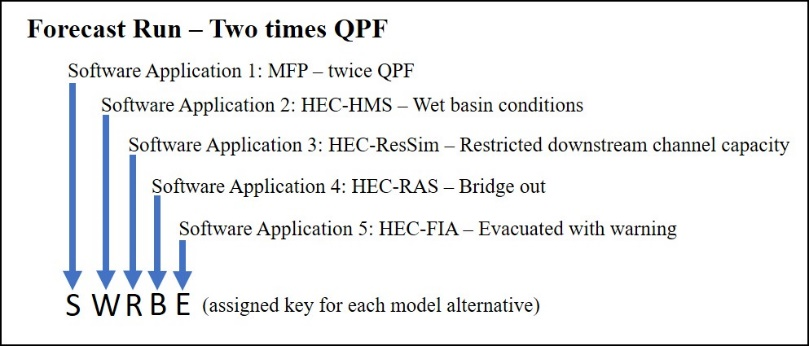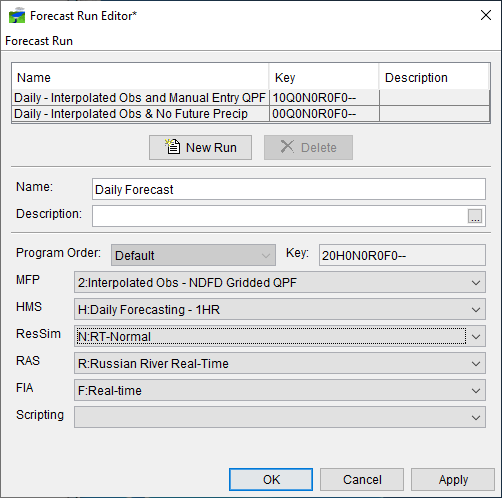Forecast Runs
A forecast run is a set of model alternatives that run sequentially during a forecast. As with model alternatives, forecast runs exist independent of time. Therefore, you can use a forecast run for any forecast time window. You create a forecast run by selecting a model alternative for each software application that could be part of an HEC-RTS forecast. There are five standard software applications in HEC-RTS, a typical forecast run will include a combination of five model alternatives. When you execute a forecast, HEC-RTS executes the software applications in sequential order.
The table below provides suggested forecast runs. The codes are the names HEC-RTS automatically assigns to each forecast run based on the one-character model alternative keys you have assigned to the model alternatives. This coding is program order dependent.
Example Forecast Runs | |
Name | Code |
No future precip | NNNNN |
QPF | QNNNN |
Two times QPF | SWRBE |
In the following example (Figure 1), the forecast run - Two times QPF has a key code of SWRBE. Each character is the key code that was assigned to each model alternative for each of the five standard software applications in HEC-RTS.

Before creating a forecast run, you must have model alternatives. Model Alternatives and Forecast Runs provides details on how to create model alternatives. Creating forecast runs occurs in the Setup module. Further details on managing forecast runs (e.g., opening, deleting) is provided in Model Alternatives and Forecast Runs.
Creating a forecast run:
- From the HEC-RTS main window, click the Setup tab, from the Models menu, click Forecast Runs. The Forecast Run Editor (Figure 2) will open.

- Click New Run, enter a new forecast run name in the Name box (required), a description in the Description box (optional).
- From the Program Order list (Figure 2), select a program order. Program Order provides detailed information on program order.
- From the software applications list (Figure 2), select the individual model alternates required for the forecast run. As you are selecting those model alternatives, in the Key box (Figure 2), HEC-RTS is automatically creating the key for the forecast run, based on the individual model alternative keys (Setup Module).
- From the File menu, click Save. The new forecast alternative appears in the table on the Forecast Run Editor (Figure 2). Click OK, the Forecast Run Editor closes.
- It is recommended at this point to save your watershed. From the HEC-RTS main window, from the File menu, click Save Watershed.